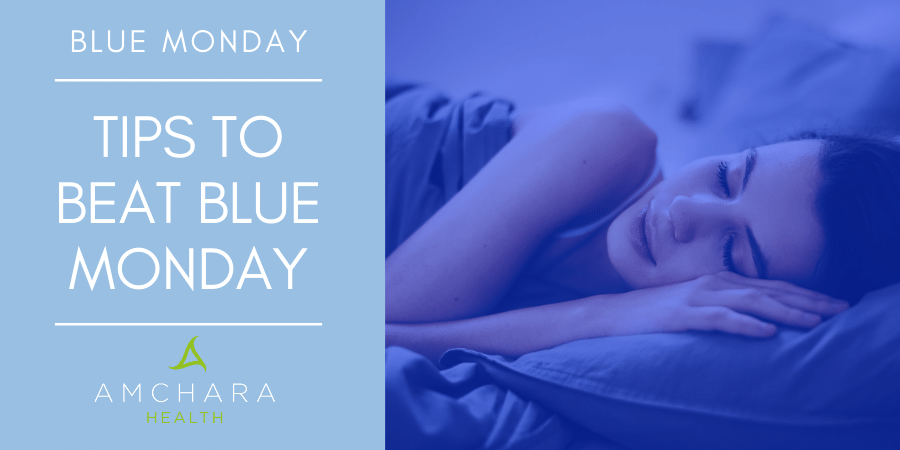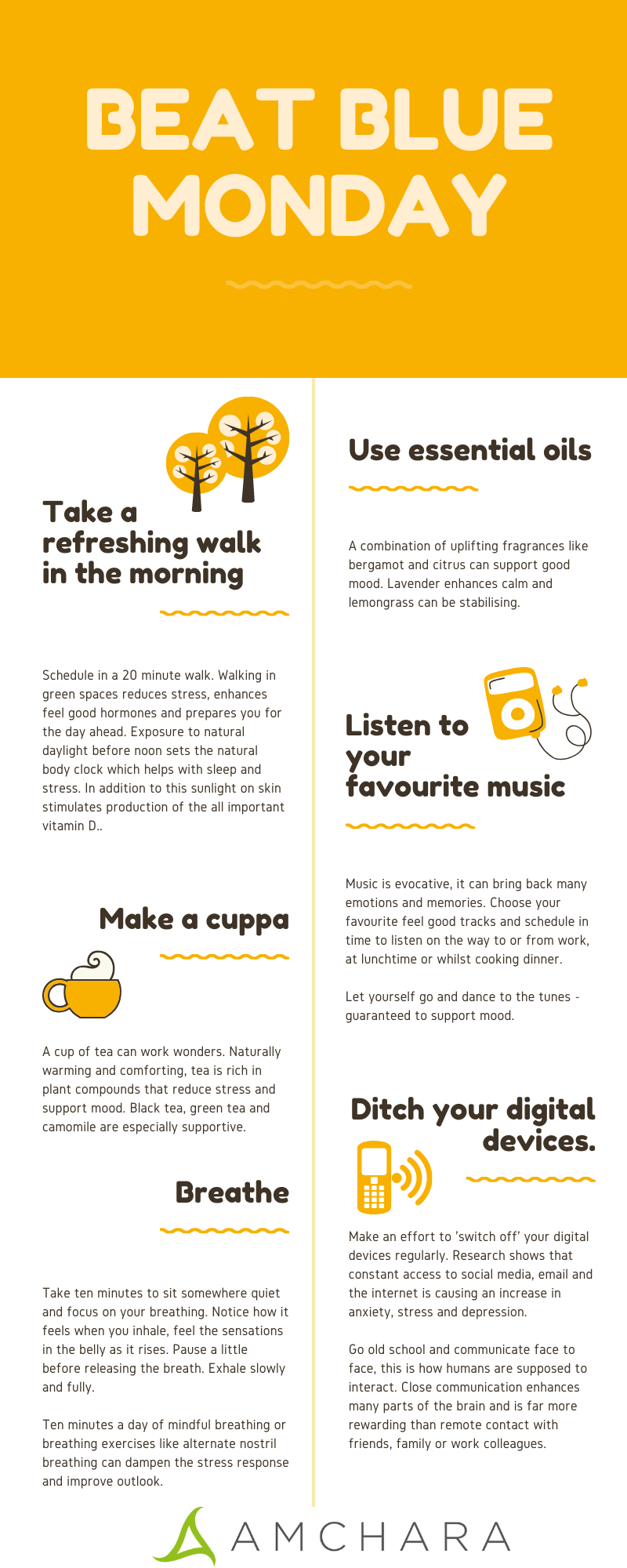Topics Covered in this article:
The third Monday in January has been dubbed Blue Monday as it is reported to be the most depressing day of the year. Seasonal mood issues are relatively common and may occur due to a myriad of reasons.
Is Blue Monday inevitable? How prevalent is it? How can Blue Monday be prevented?
In this article we discuss our top 5 tips to ease seasonal blues and tackle Blue Monday head on.
What is Blue Monday?
The festive period is over. Normality resumes. January brings colder, darker days, bills from Christmas spending begin to pop through the letterbox and New Year’s resolutions can begin to fade.
The combination of these factors is thought to come to a head around three weeks after the seasonal festivities end, and may contribute to low mood and reduced motivation. The term ‘Blue Monday’ was first developed in 2005 by Cardiff University lecturer, Dr Cliff Arnall who used a mathematical equation to propose the existence of the most depressing day of the year.
Is Blue Monday inevitable?
The basis of Blue Monday involves many factors and doesn’t really take into account an individual’s personal circumstances. There is no solid scientific evidence to show the phenomenon of ‘Blue Monday’ exists – is it a real issue?
What is known is that seasonal mood issues do occur. Up to 6% of the UK population is thought to suffer with Seasonal Affective Disorder (SAD) and around 15% of cases of depression show a seasonal pattern (1).
Common symptoms associated with seasonal mood issues include:
- Lethargy
- Irritability
- Persistent low mood
- Loss of pleasure in day to day life
- Sleep disturbances
- Appetite changes
For those with a history of depression, stress or anxiety, the effects of Blue Monday may be more profound than for others. Tackling mood issues can be tricky and may involve making several changes. Blue Monday is not inevitable – being proactive, staying ahead of the winter blues by taking positive steps can help keep it at bay.
Here are Amchara’s top 5 tips to tackle Blue Monday:
#1 – Sleep
A good night’s rest can work wonders for your mood. There is a strong link with disrupted sleep and mood disorders; depression and insomnia often go hand in hand. The impact of disturbed sleep on mental health can be significant, research shows that just one night of broken sleep can lead to a 30% increase in anxiety (2), an increase in irritability and a reduction in concentration and performance.
Obtaining good sleep can be easier said than done. The key is for long term sleep management and a healthy sleep routine is important.
Avoid all blue light emitting devices, like smartphones, tablets, eBook readers and laptops (it may also be wise to reduce television viewing) for at least 90 minutes before bed. When your eye senses blue light, this disrupts production of the normal sleep hormone, melatonin (3).
Make sure your bedroom is free from digital devices and other disturbances, and ensure bedding is comfortable. Keep the room at around 18°C, the optimal temperature for sleeping. Use ear plugs or an eye mask to block out disruptive noises or light.
Set the scene each night with a calming activity like reading or listening to soft soothing music and consider having a hot bath – add in essential oils like lavender or magnesium salts to further aid relaxation. It has been shown that the reduction in body temperature following a hot bath stimulates the onset of sleep (4).
#2 – Seek daylight
Human beings are naturally diurnal (active during the day); daylight provides vital cues to the body and is essential for efficient functioning. Your body has a natural circadian rhythm and disruptions to this rhythm are known to impact depression (5) as well as many other functions.
Resetting the natural circadian rhythm through several actions, also called chronotherapy, can give significant benefits to mood.
As light is a major factor in resetting or maintaining a healthy circadian rhythm, it is important to obtain good levels of natural daylight. Exposing the eyes to half an hour or more of daylight before noon is as essential as avoiding blue light devices in the evening. Exposing your skin to sunlight at the same time enhances vitamin D production; low levels of vitamin D have been seen in cases of depression and SAD (6).
Make time to walk or cycle to work, or get off public transport a stop or two early. Enjoy a walk in fresh air at lunchtime or eat your lunch outdoors. Making small but simple changes to daylight exposure can have a large impact on how the body functions and bright light therapies have been shown to improve symptoms of many mental health conditions (7).
#3 – Be active
Leading a sedentary life has been linked to the development of many chronic health conditions and poor mental health. The human body is designed to be active – think back to hunter gatherer times when the whole day was spent searching for the next meal.
Remaining as active as possible can help to combat Blue Monday and long term mood issues.
Walking in green spaces such as the woods or a local park seems to further enhance the mood improving benefits of walking. If it is difficult to immerse yourself in nature regularly, remember that simply walking anywhere is still beneficial.
Use the stairs where possible and embrace housework or gardening – it all counts.
Another good tip is to set an active alarm during work hours to remind you to get up and move from your desk, at least every 30 minutes. This can be a great excuse to make a hot drink or drop in on a colleague to discuss an issue, rather than just emailing.
Incorporate regular cardiovascular exercise such as swimming, cycling, jogging, rowing or an exercise class, at least 5 times a week. A couple of good weight bearing sessions a week gives extra benefits. This can be done using hand weights or body resistance. No gym membership is required as there are plenty of options for exercising at home or in the park.
If time is an issue then High Intensity Interval Training (HIIT) can be a quick alternative. This type of exercise uses maximum effort in a short amount of time and seems to bring similar benefits to more prolonged exercise.
#4 – Be mindful of food choices
There is no denying what you eat can impact your mood. There are many ‘good mood foods’ and ensuring nutritional balance is key for providing your body with essential nutrients for it to function optimally.
Foods rich in omega-3, like oily fish and walnuts, are well known to support good mental health (8). The Mediterranean diet, rich in oily fish, fresh fruits and vegetables, whole grains, legumes and nuts, has consistently been shown to be one of the most beneficial for mood (9).
Refined, processed, white foods or simple sugars and a high intake of caffeine or alcohol, can wreak havoc when it comes to your blood sugar balance. This can set up a cascade of hormonal changes that may influence mood.
Choose whole grains, rich in fibre, and eat at least 8 portions of fruit and vegetables a day. Include good proteins like oily fish, chicken, turkey, eggs, quinoa, nuts, lentils and beans in each meal to give a good balance and help prevent cravings for sweet foods.
A good protein rich breakfast on Blue Monday can help set you up for the day. Try scrambled eggs or tofu with grilled tomatoes and mushrooms, or a pea and rice protein smoothie. Adding ground almonds to porridge can increase protein content.
Steer clear of sweets, confectionary, pastries, cakes and biscuits which don’t carry much nutritional value.
It may also be beneficial to be mindful of when you eat, as well as what you eat. The topic of intermittent fasting and time restricted eating is providing some interesting evidence. This area of health is relatively new and studies in rodents show that intermittent fasting has an antidepressant-like effect (10). There are few comprehensive studies in humans at this stage, but one study following nurses fasting during Ramadan indicated they experienced a significant reduction in depression following the fasting period compared to before (11).
#5 – Breathe
Breathing is under unconscious control and on average a person takes 15- 18 breaths per minute. That’s almost 22,000 breaths per day! How many of those breaths are you aware of? Do you recall sensations experienced during your last breath?
Mindful breathing and specific breathing exercises have been shown in several studies to have a calming, balancing effect and are thought to not only reduce the impact of stress but improve mental health (12).
Daily breathing exercises such as 4-7-8 breathing, or alternate nostril breathing, can prepare you for the day ahead and be used as and when required. If the thought of Blue Monday fills you with dread then practice conscious breathing before it arrives. If you find yourself overwhelmed on Blue Monday, take 5 minutes to focus on how you breathe and what it feels like.
This kind of mindfulness can increase awareness and help you to put things into perspective. There are now numerous studies showing the benefits of mindfulness based cognitive therapy for depression, breathing is only a small part of this.
Takeaway
Blue Monday is based on a mathematical equation and is not necessarily a proven occurrence. Taking steps to make positive long term nutritional and lifestyle alterations can be the key to overall good mood. Challenge yourself this Blue Monday and make at least 3 changes today.
If you struggle with mood issues and would like to know more about improving your mental health, a one to one consultation with a Personalised Health practitioner can help you investigate as to whether hormonal, environmental or genetic factors are involved.
We’re dedicated to providing you with both insightful information and evidence-based content and aim to provide you with actionable knowledge and tips to help you on your journey to optimal health.
Did you find this article useful?
What are your personal tips to beat the blues?
We’d love to hear your thoughts, get in touch!
Read this next:





